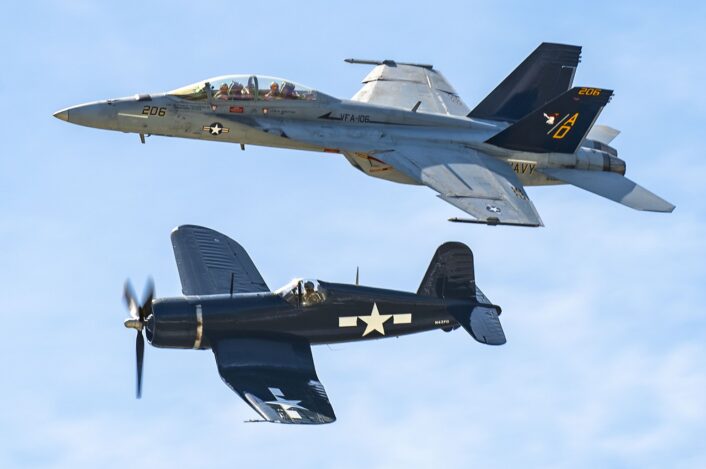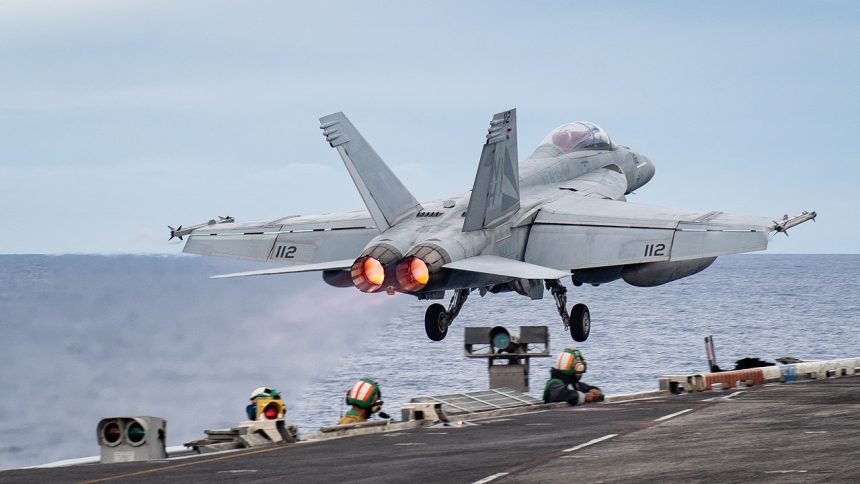The command released a presolicitation to procure production line shutdown efforts for the F/A-18E/F center aft fuselage production line from Northrop Grumman, ahead of Boeing’s planned end of the production in 2027.
The Naval Air Systems Command (NAVAIR) announced, with a contract presolicitation published on Jun. 26, 2024, its intention to procure production line shutdown efforts for the F/A-18E/F center aft fuselage production line from Northrop Grumman Aerospace Systems (NGAS). With a planned period of performance anticipated to be 24 months, this appears to be part of the planning ahead of Boeing’s planned end of the Super Hornet’s production in 2027.
After initially planning to shut down the production in 2025 because of a lack of export orders, Boeing secured earlier this year a contract for the U.S. Navy’s final Super Hornets, extending the production until spring 2027. The last contract, awarded in March, covers five single-seat F/A-18Es and 12 two-seat F/A-18Fs under production lots 46 and 47, for a total of 17 aircraft to be delivered in the Block III standard.
The tasking of the effort requested by NAVAIR includes disposition, packaging, and shipment to identified storage locations and facilities for all Government-Furnished Property (GFP), Support Equipment (SE), Special Tooling (ST), Special Test Equipment (STE), and any associated Right-to-Title production parts or material currently in custody of NGAS and their suppliers.
It thus appears that components and tooling will be stored for a possible future use, rather than being completely dismantled. These items could still be useful for other functions outside production, such as maintenance and repairs.
The presolicitiation continues mention that, as the contractor for half of the FA-18E/F aircraft, NGAS has the manufacturing knowledge, experience, and technical data required to fulfill NAVAIR’s requirement. Additionally, NGAS and its suppliers currently have physical custody of approximately 8,000 items of GFP.
The Super Hornet Service Life Modification program
The stop to the production of the Super Hornet will not affect the modernization currently in progress in the U.S. Navy F/A-18E/F fleet. In fact, these works, along with the similar EA-18G modernization, will continue on a separate production line well into the 2030s.
The Service Life Modification (SLM) program adds 4,000 flight hours to the service life of the already delivered Super Hornets, as well as applying the Block III upgrades. The first phase of the SLM program has already been in motion for some years, extending the service life of the Super Hornet from 6,000 to 7,500 flight hours.
The second phase, which started last year, is looking to extend the service life to 10,000 flight hours and perform the modifications required for the Block III upgrades. The first two aircraft to be modified have been delivered back to the U.S. Navy on Jun. 27, after less than a year and ahead of schedule.

According to the company, the aircraft were delivered one month ahead of schedule from St. Louis and two months ahead of schedule from San Antonio. The press release added that the two aircraft have the same capabilities as Super Hornets being delivered from Boeing’s new-build production line.
“Great measures were taken by the Boeing and Navy teams to ensure these are the safest and most capable Block III F/A-18s we can give our warfighters,” said Mark Sears, Boeing Fighters vice president. “These are just the first of many deliveries, with around 15 years of SLM deliveries to go.”
The company and the Navy worked closely to improve productivity and complete Block III upgrades ahead of the 15-month contract requirement. This was made possible by establishing a baseline for the condition of Block II F/A-18s received at Boeing, and the Navy’s work to prepare the jets in advance, as well as sharing information and best practices across multiple SLM sites to improve efficiency, manage workload distribution and optimize resource allocations.
“Our success in meeting the accelerated timeline is proof our service life modification game plan is working,” said Faye Dixon, Boeing SLM director. “Thanks to our years of learning on the program and our partnership with the Navy, the F/A-18 Super Hornet remains at the forefront of defense technology with renewed years of service to support the fleet.”
The first two F/A-18 #SuperHornet to receive the Block III Avionics kit + 4,000 flight-hours extension through Service Life Modification (SLM) flew home to the @USNavy.
Learn how #TeamBoeing SLM employees worked together to ensure Block III capability is delivered to the fleet. pic.twitter.com/pEwYFmA5AO
— Boeing Defense (@BoeingDefense) June 27, 2024
The Super Hornet Block III
The key capabilities made available by the new variant include Advanced Cockpit System centered around the 10×19 inch large-area touchscreen display, an advanced network infrastructure that incorporates the Distributed Targeting Processor Network (DTP-N) and the Tactical Targeting Network Technology (TTNT), open mission systems, reduced radar signature, a 10,000-hour airframe, the AN/ASG-34 IRST (Infrared Search-and-Track) and Conformal Fuel Tanks (CFT) with an additional 3500 lb fuel capacity.
There are currently three work lines involved in the program, two in St. Louis and one at the Fleet Readiness Center Southwest, which can modify up to 40 aircraft per year. In 2022, Rear Adm. Andrew Loiselle, director of Air Warfare Division in the Office of the Chief of Naval Operations, mentioned that the implementation of best practices during Phase One SLM allowed a 30% percent cost reduction. The initial SLM budgeted cost per aircraft was $5.5 million, with a turnaround time of 15-17 months.
The number of aircraft that will be upgraded and see their service life extended is not yet clear, as the Navy has not yet finalized it. The SLM however will be used to control the availability of the aircraft, eventually ramping up or scaling down the program according to future budgets, schedules and requirements.
Thanks to this upgrade, the Super Hornet and the similarly upgraded Growler will continue to serve in the U.S. Navy for the decades to come. ”The Super Hornet remains a predominant aircraft in the carrier air wing and will continue to provide significant combat capability into the 2040s,” says Rear Admiral John Lemmon, the navy’s program executive officer for tactical aircraft.









